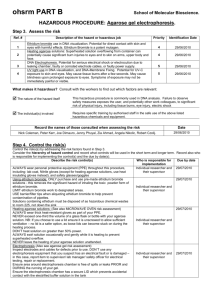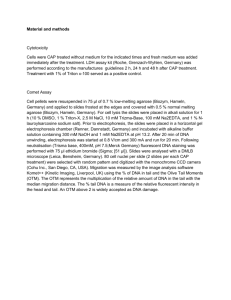Health and Safety Risk management form
advertisement
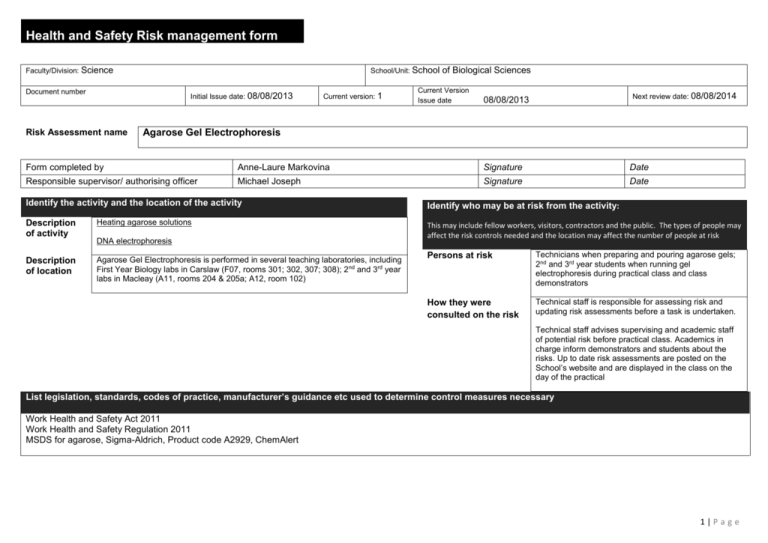
Health and Safety Risk management form Faculty/Division: Science School/Unit: School Document number Initial Issue date: 08/08/2013 Risk Assessment name Current version: 1 of Biological Sciences Current Version Issue date Next review date: 08/08/2014 08/08/2013 Agarose Gel Electrophoresis Form completed by Anne-Laure Markovina Signature Date Responsible supervisor/ authorising officer Michael Joseph Signature Date Identify the activity and the location of the activity Description of activity Heating agarose solutions Description of location Agarose Gel Electrophoresis is performed in several teaching laboratories, including First Year Biology labs in Carslaw (F07, rooms 301; 302, 307; 308); 2nd and 3rd year labs in Macleay (A11, rooms 204 & 205a; A12, room 102) DNA electrophoresis Identify who may be at risk from the activity: This may include fellow workers, visitors, contractors and the public. The types of people may affect the risk controls needed and the location may affect the number of people at risk Persons at risk Technicians when preparing and pouring agarose gels; 2nd and 3rd year students when running gel electrophoresis during practical class and class demonstrators How they were consulted on the risk Technical staff is responsible for assessing risk and updating risk assessments before a task is undertaken. Technical staff advises supervising and academic staff of potential risk before practical class. Academics in charge inform demonstrators and students about the risks. Up to date risk assessments are posted on the School’s website and are displayed in the class on the day of the practical List legislation, standards, codes of practice, manufacturer’s guidance etc used to determine control measures necessary Work Health and Safety Act 2011 Work Health and Safety Regulation 2011 MSDS for agarose, Sigma-Aldrich, Product code A2929, ChemAlert 1|P a g e Consider the hierarchy of hazard control and record what controls will be used in the short term and longer term Elimination Not possible Eliminate the hazard or task if the risk outweighs the potential benefits. Substitution Not possible Substitute the hazard with something less hazardous e.g. less toxic substance. Isolation Not possible Isolate the hazard by using barriers or distance. Engineering Not possible Look for physical design solutions, controls, safety lockouts or automation to reduce or eliminate risks. Minimise Not possible Minimise the size or volume of the hazard or time of exposure to the hazard. Rearrange Workflow Not possible Rearrange activities to minimise lifting/handling/overuse injuries Administrative Possible Establish Safe Work Practices e.g. restrict access, have Safe Work Practice documentation and procedures for hazardous tasks. Training and Supervision Possible Provide training and supervision appropriate to level of expertise of the person(s) involved. Record training in SWP. Personal Protective Equipment Possible Use only as a secondary measure to supplement other risk controls e.g. gloves, lab coats, safety glasses. Identify hazards and control the risks. 1. An activity may be divided into tasks. For each task identify the hazards and associated risks. Also list the possible scenarios which could sooner or later cause harm. 2. Determine controls necessary based on legislation, codes of practice, Australian standards, manufacturer’s instructions etc. 3. List existing risk controls and any additional controls that need to be implemented Task or Hazard Associated harm Existing risk controls Current risk Scenario Heating agarose solutions DNA electrophoresis Superheated solutions Super heating of overflowing from bottles agarose solution to melt can potentially cause agarose powder significant burn injuries to skin on hands and arms Running electrophoresis Potential for serious electrical shock or electrocution due to leaking chamber, faulty or corroded electrode cables or faulty power supply ALWAYS wear heat resistant gloves when handling hot agarose bottles NEVER fill a glass bottle/flask to more than 1/3 of the container’s total volume IF USING GLASS BOTTLES, ensure that lid is unscrewed before heating solution in microwave DO NOT heat solution above 50% power ALWAYS swirl solution gently during heating to prevent superheating NEVER leave heating of agarose solutions unattended Inspect electrodes and cables for defects before use. DO NOT use electrophoresis equipment suspected of electrical fault or damage. Report any defects to lab manager/safety officer for repairs or replacement ENSURE area around electrophoresis chamber is free of leaks or spills BEFORE and DURING electrophoresis ENSURE electrophoresis chamber has a secure lid, which prevents accidental contact with the electrified buffer solution in the tank Any additional controls required? Medium None Medium None Residual risk Low Low 2|P a g e List emergency procedures and controls List emergency controls for how to deal with fires, spills or exposure to hazardous substances and/or emergency shutdown procedures For smaller burns, wash and cool the area under cold running water until the skin returns to normal temperature (up to 20 minutes for a thermal burn, at least 20 minutes for a chemical burn or 30 minutes for a bitumen burn). If this is not possible apply a cold-water compress. Do not use iced water as this can worsen the injury DO NOT remove clothing or anything that is sticking to the burn. It helps to protect against infection and prevent fluid loss Cover the burn with clean, non-stick material, such as a freshly washed pillowcase. Fix it in place with a scarf or a piece of clean cloth. Clean plastic cling wrap can be a useful dressing DO NOT use adhesive dressings, apply fat, ointment or lotion, break a blister or touch a burn If the burn is larger than a 20 cent coin, see your doctor or go to the emergency department of your local hospital If the person suffered an electrical burn, take patient to the nearest hospital St John Ambulance Australia. Managing burns and scalds (updated Sep 2012). http://www.stjohn.org.au/images/stjohn/information/fact_sheets/FS_burns.pdf (accessed Mar 2013) Implementation Additional control measures needed: None Resources required Responsible person REVIEW Scheduled review date: Are all control measures in place? 12 months 2 years Date of implementation 3 years Are controls eliminating or minimising the risk? Are there any new problems with the risk? Review by: (name) Review date: Acknowledgement of Understanding All persons performing these tasks must sign that they have read and understood the risk management. Note: for activities which are low risk or include a large group of people (e.g. open days, BBQ’s, student classes etc), only the persons undertaking the key activities need to sign below. For all others involved in such activities, the information can be covered by other methods including for example a safety briefing, induction, and/or safety information sheet (ensure the method of communicating this information is specified here) Risk management name and version number: Name I have read and understand this risk management form Signature Date 3|P a g e 4|P a g e
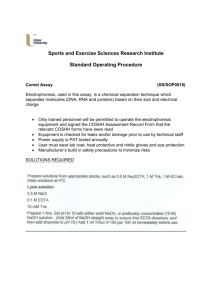
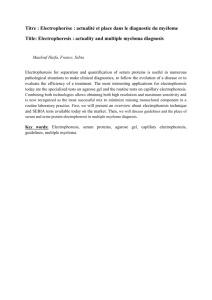


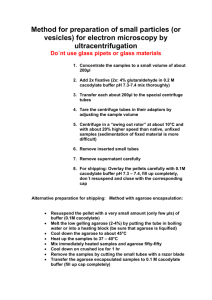
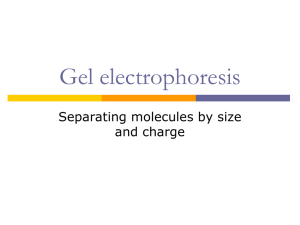
![Student Objectives [PA Standards]](http://s3.studylib.net/store/data/006630549_1-750e3ff6182968404793bd7a6bb8de86-300x300.png)
